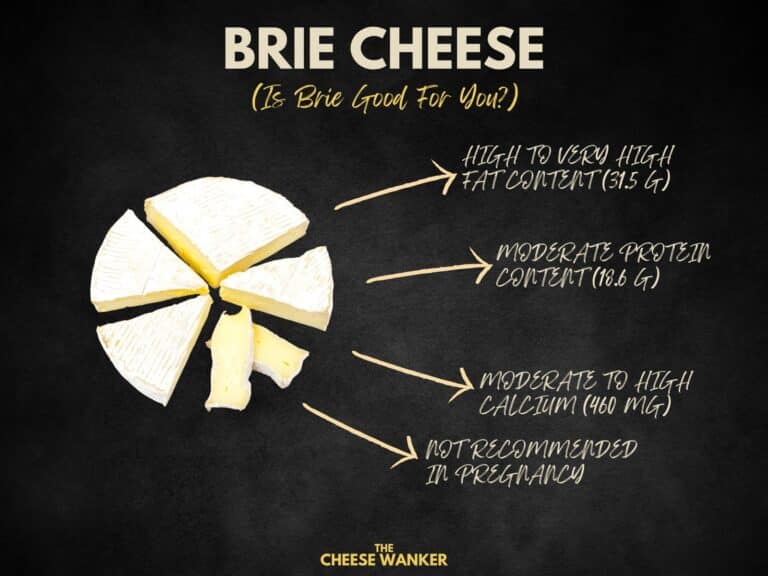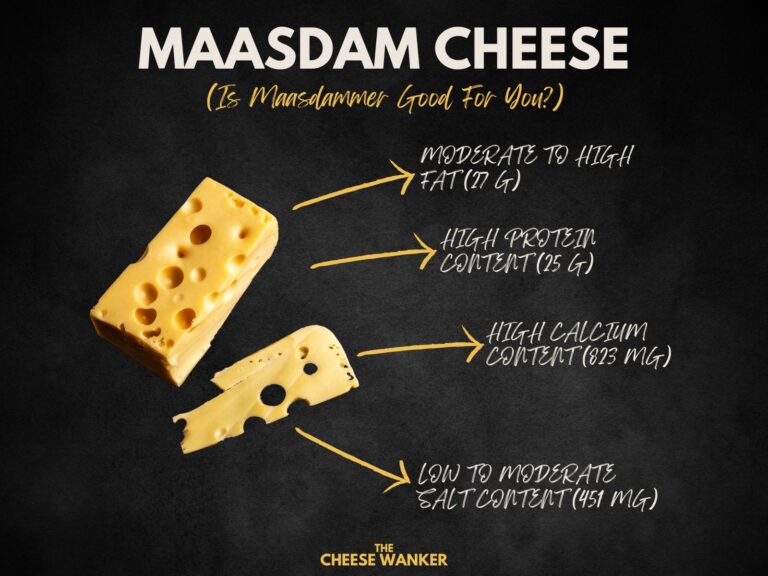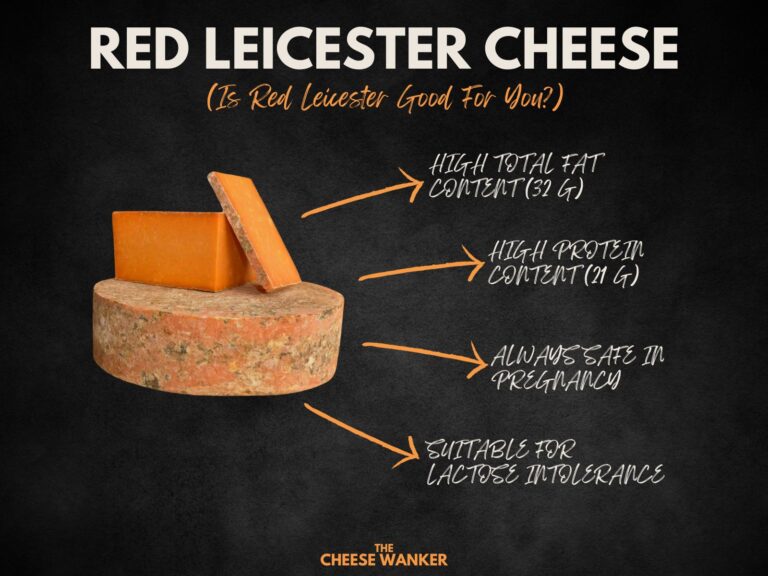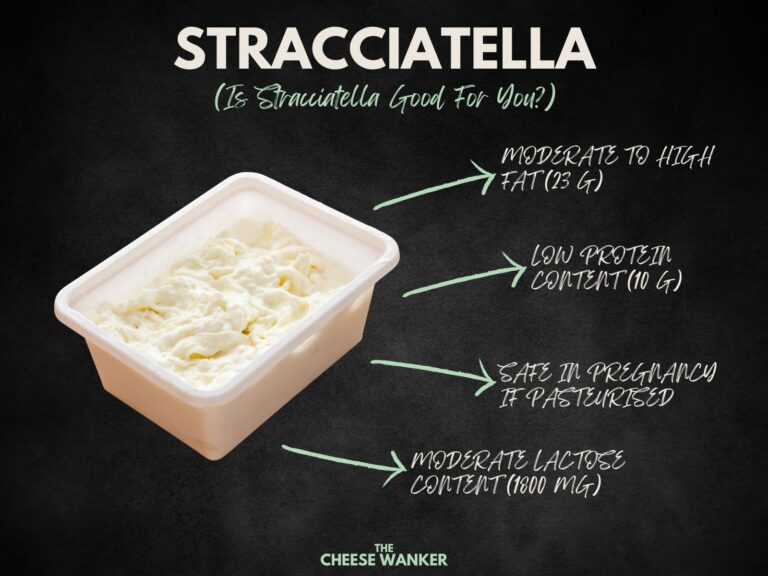Burrata, a delicacy originating from southern Italy, has gained popularity worldwide for its creamy texture and rich flavour. In this post, we delve into the nutrition facts for Burrata, shedding light on its composition and addressing various aspects, such as lactose intolerance, protein content and safety in pregnancy.
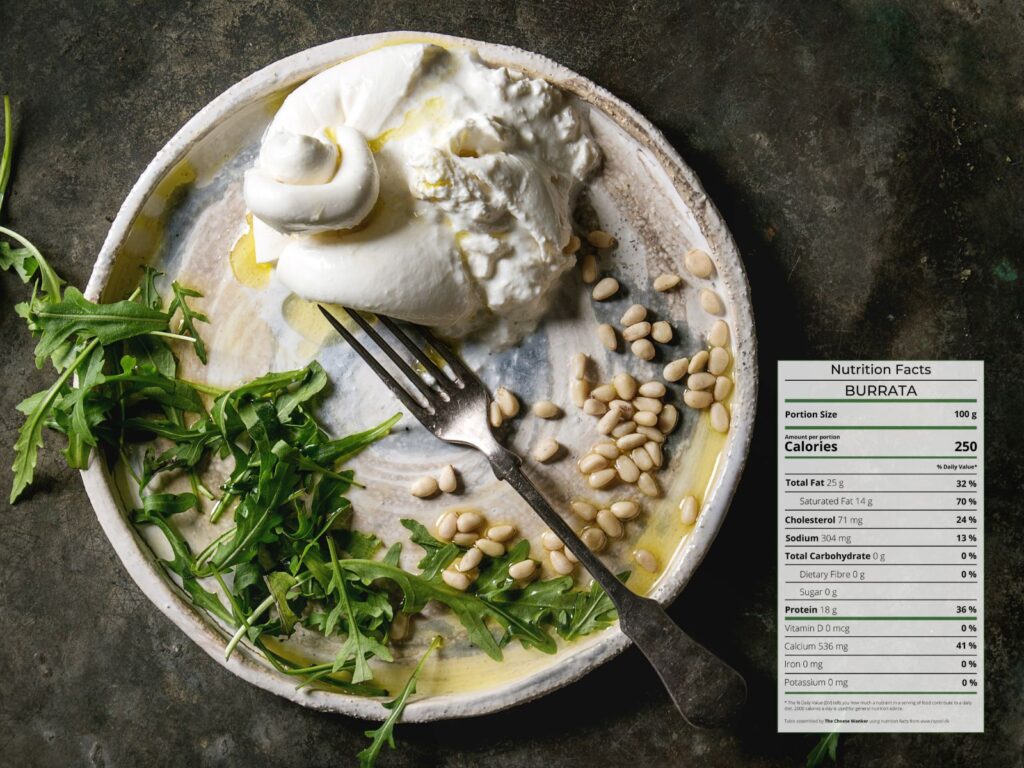
SEE ALSO: Nutrition facts for popular world cheeses in The Cheese Wanker’s index →
What is Burrata?
Burrata is a fresh Italian pasta filata cheese made from cow’s milk. It is crafted by combining Mozzarella and cream, resulting in a delectably creamy interior. The outer shell, made of a Mozzarella skin, encases the luscious centre, creating a delightful contrast of textures.
Due to its artisanal nature, Burrata is typically consumed fresh and has a relatively short shelf life.
You can read more about these delightful cheesy parcels from Puglia in our dedicated post here.
Nutrition fact sheet
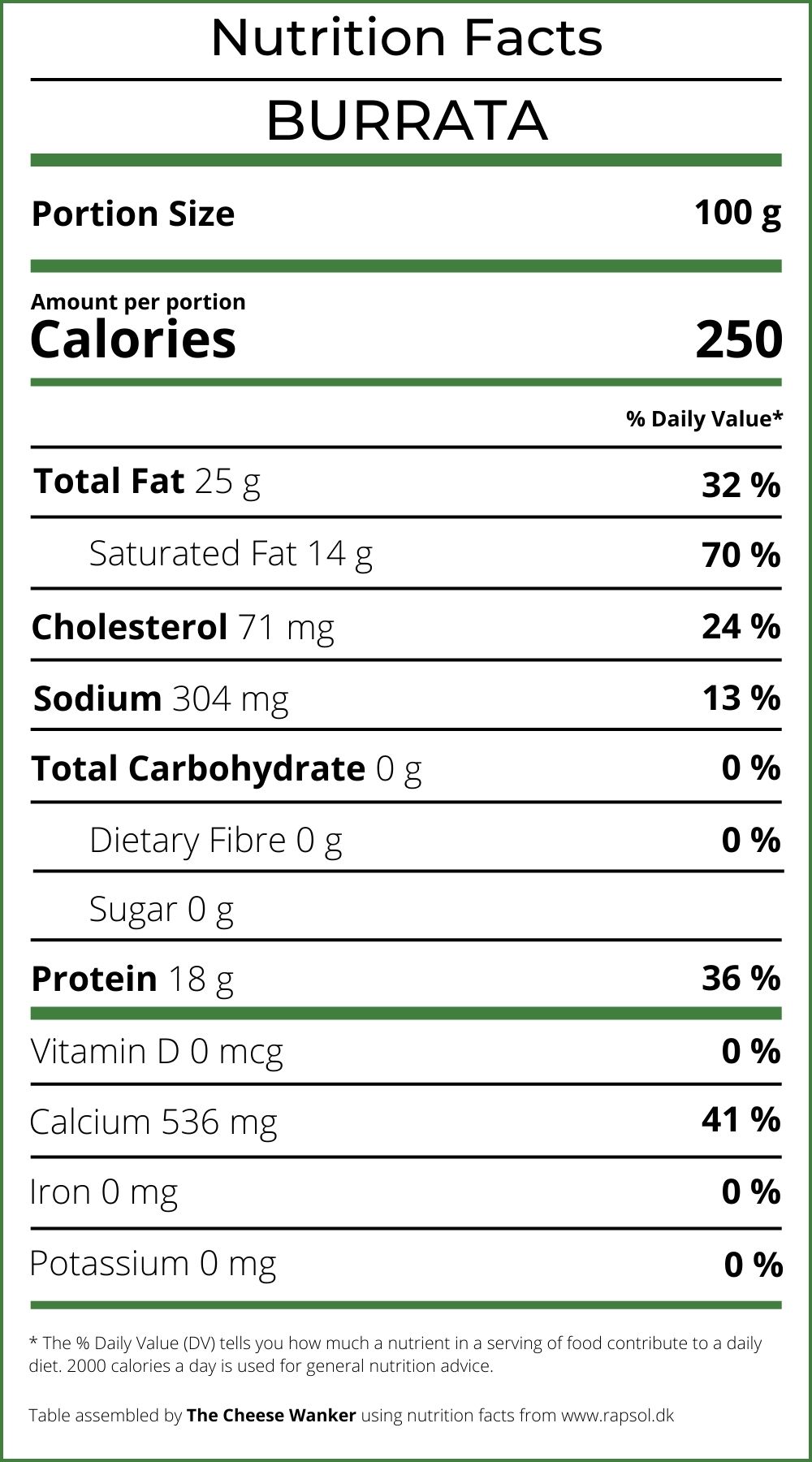
Nutritional review for Burrata
Eating healthy plays a pivotal role in maintaining overall well-being and preventing chronic diseases. A balanced and nutritious diet provides our bodies with essential vitamins, minerals, and macronutrients, fuelling optimal physical and cognitive function.
With this in mind, let’s have a look at some of the key nutrition facts for Burrata.
Lactose Intolerance
For individuals with lactose intolerance, the good news is that Burrata is generally well-tolerated. During the production process, much of the lactose in the milk is converted into lactic acid by bacteria cultures.
This conversion significantly reduces the lactose content in Burrata, making it a viable option for those with lactose intolerance. However, it is advisable to monitor your personal tolerance levels and consult with a healthcare professional if necessary.
Fat Content
Burrata boasts a relatively high fat content due to the addition of cream during its preparation. The fat content in Burrata can range from 20% to 30% or more, depending on the specific brand or artisanal production methods.
It is important to consume Burrata in moderation, particularly if you are following a low-fat diet. On the other hand, this Italian pasta filata contains little to no carbohydrates. As such, it is a fantastic option for cheese lovers on a ketogenic diet.
You can learn more about the different types of fat in cheese and which cheeses have the lowest fat content here.
Cholesterol Content
While Burrata contains a higher amount of fat, it is worth noting that cheese, in general, contributes to dietary cholesterol intake. On average, Burrata contains about 70 mg of cholesterol per 100 g serving of cheese.
However, the impact of dietary cholesterol on blood cholesterol levels varies among individuals, and it is advised to consider your overall dietary pattern and consult a healthcare professional if you have specific concerns.
Protein Content
Furthermore, Burrata cheese provides a moderate amount of protein, making it a suitable addition to a balanced diet. Protein is essential for various bodily functions, including tissue repair and the production of enzymes and hormones.
Incorporating Burrata as part of a meal or snack can contribute to your overall protein intake, especially if combined with other protein-rich sources.
Want to find out which cheeses have the highest protein content? Click here for our blog post covering cheeses with the highest protein content.
Safety in Pregnancy
Pregnant women often seek guidance regarding the safety of consuming certain foods. Burrata made from pasteurised milk is generally considered safe during pregnancy.
However, it is advisable to ensure the cheese is fresh, properly stored and consumed before the best before date to minimise any potential risks. If unsure, consult your healthcare provider for personalised advice.
You can read more about which cheeses you can eat when you’re pregnant by clicking here.
Salt Content
Unsurprisingly, Burrata, like most cheeses, contains salt. The specific salt content may vary depending on the production process and the seasoning used.
Hence, individuals with high blood pressure or those aiming to reduce sodium intake should be mindful of their Burrata consumption and consider alternatives with lower sodium content.
You can read more about why salt is important in cheesemaking in our comprehensive post here.
Calcium Content
Calcium, an essential mineral for bone health and various bodily functions, is found abundantly in Burrata. The calcium content can vary depending on the specific brand or production methods but is usually in excess of 500 mg per 100g.
Including Burrata as part of a balanced diet can contribute to meeting your daily calcium requirements, particularly if you are lactose intolerant and seek alternative sources of this vital mineral.
Conclusion
Burrata, with its creamy texture and delightful taste, offers a unique culinary experience. While it is relatively high in fat and contains varying amounts of cholesterol, it also provides protein and important minerals like calcium.
For individuals with lactose intolerance, Burrata can be a suitable option due to its lower lactose content. Pregnant women should ensure that the cheese is made from pasteurised milk and consumed within the recommended guidelines.
As with any food, moderation is key. By understanding the nutritional facts of Burrata, you can enjoy this cheese as part of a balanced and varied diet, savouring its delicious attributes while meeting your nutritional needs.
References
Overall nutritional content
The nutritional content of cheese in our table comes from the USDA Food Data Central Repository, the Australian Food Composition Database and cheese manufacturers. We realise that there can be variations between different brands and producers. Hence, the numbers we have used are averages.
Fat content
Our fat RDI data comes from Cleveland Clinic’s Healthy Fat Intake resource.
Type of fat in cheese as per Harvard T.H. Chan’s The Nutrition Source.
Protein content
Our protein RDI data comes from Harvard Medical School’s Harvard Health Publishing.
Cholesterol content
Is There a Correlation between Dietary and Blood Cholesterol? Evidence from Epidemiological Data and Clinical Interventions? – Maria Luz Fernandez and Ana Gabriela Murillo
Saturated fat, carbohydrate, and cardiovascular disease – Patty W Siri-Tarino, Qi Sun, Frank B Hu and Ronald M Krauss
Effect of cheese consumption on blood lipids: a systematic review and meta-analysis of randomized controlled trials – Janette de Goede, Johanna M Geleijnse, Eric L Ding, Sabita S Soedamah-Muthu
Safety in pregnancy
All the advice relating to what cheeses you can eat during pregnancy in this article is based on the recommendations by health authorities in Australia, the UK and the USA. If you are unsure about what you can or cannot eat, please consult your doctor.
Australia – FSANZ, United Kingdom – NHS and United Sates of America – FDA
Lactose content
Lactose residual content in PDO cheeses
Detection of lactose in products with low lactose content
The analysis of lactose in milk and cheese products by HPLC
Food Standards ANZ Food Composition Database
Lactose & Galactose content of cheese
